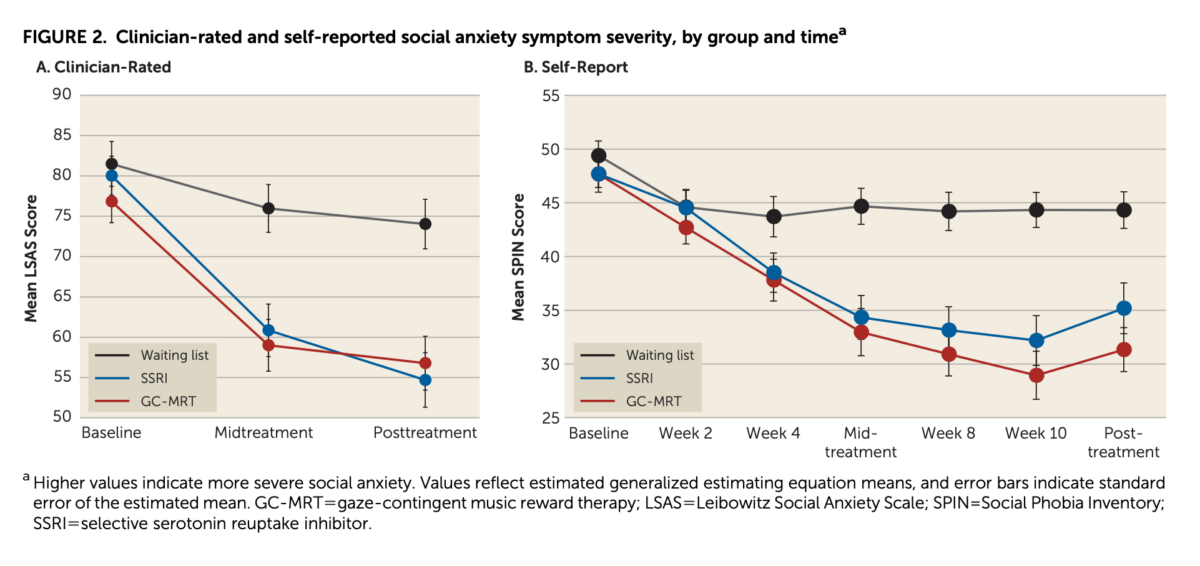Innovative Treatment as Effective as Psychiatric Drug for Social Anxiety Disorder: Study
A new technology-driven treatment was found to be as effective as psychiatric medication for treating social anxiety disorder, according to a recent clinical study.
The study compared gaze-contingent music reward therapy (GC-MRT), which is based on eye-tracking technology that allows for treatment of social anxiety disorder (SAD) through changing attentional biases in patients, with a selective serotonin reuptake inhibitor (SSRI) drug treatment in reducing SAD symptoms.
The paper was published in the American Journal of Psychiatry.
One hundred and five adults with SAD were randomly allocated into three groups: one group was treated with Cipralex, which is an SSRI drug used as first-line treatment; a second group was treated with GC-MRT; and a control group (which included patients who were told they would receive GC-MRT sessions following a 12-week waiting period).
All the participants underwent a complete clinical assessment before and after the treatments and they were asked to report on their symptoms and their severity.
Mean changes in clinician-rated and self-reported social anxiety symptoms from baseline to mid- and post-treatment assessments were compared between the groups. The researchers also examined changes in attentional dwell time on threat.
Depression was assessed at the pre- and post-treatment assessments as well “given the high comorbidity between social anxiety disorder and depression” according to the study. Based on previous studies, the researchers expected to see improvement in depressive symptoms only in the SSRI group.
After ten sessions that lasted for 20 minutes over a 12-week period, about 50 percent of the participants in the GC-MRT treatment group showed significant improvement in their symptoms—similar to the results found in patients who received Cipralex.
Individuals in the GC-MRT and SSRI treatment cohorts showed lower SAD scores at the mid- and post-treatment assessments compared with the control group. There was no difference in the efficacy of both treatments.

In addition, individuals in the GC-MRT group showed a reduction in the amount of time they dwelled on threats from baseline to post-treatment assessment.
SAD
Social anxiety is characterized by the constant fear of social or performance situations in which the individual is exposed to unfamiliar people or to the possibility to be scrutinized by others, according to the NIH website. About 12 percent of U.S. adults experience this disorder at some point in their lives.
The most common example is standing in front of an audience, but it doesn’t have to be a large crowd, Yair Bar Haim, director of the Adler Center for Child Development and Psychopathology, and of the Center for Traumatic Stress and Resilience at Tel Aviv University, who led the study, told The Epoch Times. These individuals might experience anxiety even when eating with company, and they may experience all the classic anxiety symptoms such as sweating, palpitations, and shortness of breath.
Quite often, people with this disorder avoid social situations—at a heavy interpersonal, professional, and economic price.
“It is a serious disorder that usually does not go away without treatment,” Bar Haim said.
One of the main things known about people who suffer from anxiety disorders in general and SAD in particular is that they have an attentional preference to threatening stimuli in their environment, he said.
For example, if you stand in front of an audience, most of the people will have neutral or positive faces, but there might be one or two that look a little more negative. People with SAD tend to direct their attention to those negative faces and they find it difficult to disconnect from there.
“GC-MRT reduces this tendency through feedback,” according to the study.
The treatment we developed reduces this bias of these people, it normalizes it and thus lowers the symptoms, said Bar Haim.
Participants were shown a display of faces in a matrix on a computer screen. The display included both negative and neutral faces. The computer tracked where the users’ gaze fell throughout the session.
“We slowly rewire their attention patterns and normalize them,” said Bar Haim.
When the patient fixated on neutral faces, a music track they had selected beforehand would play. When they fixated on threatening faces the music stopped.
“This lowers the feeling of anxiety. It significantly lowers the symptoms,” he said.
We already proved the efficacy of this treatment in a preliminary controlled study, Bar Haim said, adding that other labs around the world replicated the results.
Currently, a large-scale study replicating the research is being done at Columbia University in New York, led by Franklin Schneier, associate professor of Clinical Psychiatry at the College of Physicians and Surgeons of Columbia University and assistant director of the Anxiety Disorders Clinic at the New York State Psychiatric Institute. Intermediate results have shown the treatment to be effective.
The current study found that SSRI treatment was associated with lower depression compared to the control group. This difference was not observed for the GC-MRT cohort. These results, similar to findings in other reports, “may suggest an advantage of SSRI treatment over GC-MRT in patients with comorbid depression,” the researchers wrote in the paper.
The study also included MRI scans before and after both treatments, Bar Haim said. The scans showed that there are areas in the brain that react in a similar way to the drug and to the GC-MRT, meaning both treatments result in a similar response in the brain. Yet one specific area responded uniquely to the GC-MRT, which is an area in the anterior cingulate cortex (ACC) that is responsible for directing and regulating attention.
The additional findings will be published in a following paper currently under review, according to Bar Haim.
The authors recognized that the main limitations were that the current study did not include a follow-up on the treatment outcomes, as SSRI treatment continuation is recommended for at least a year.
In addition, both treatments “were limited in their overall clinical effectiveness,” the researchers wrote. Mean clinician-rated total severity scores remained above the suggested clinical cutoff at the post-treatment assessment. Less than 50 percent of the participants showed reliable change.
New Effective Alternative
Currently, there are two main types of treatment for SAD, said Bar Haim.
One is SSRI drugs, like Cipralex. The second is cognitive behavioral therapy (CBT). However, there is quite a relapse with these two treatments and the success rates are between 50–60 percent, he said. That means that there are quite a lot of people for whom the existing treatment does not help, so “it is good to have another tool” to offer.
Not every patient can get drug treatment for several reasons. Some individuals are not enthusiastic about taking psychiatric drugs, some have medical conditions that do not allow them to take the drugs, which also have certain side effects. So this new treatment is “a good alternative” for these people.
While the CBT treatment is effective and non-invasive—it does not involve taking drugs—it does require patients to face their fears directly, usually done by exposing them to fear directly, said Bar Haim. Many patients are unable to withstand this, so the dropout rate is relatively high (16–37 percent).
CBT requires 12–20 sessions with very skilled therapists who have at least 10 years of training, and there is a serious shortage of these trained professionals.
The new treatment is “an effective treatment with several advantages,” said Bar Haim. It is more technical, easy to use, and simple, and the dropout rate is lower (6 percent according to the current study). Efficiency is similar to CBT treatment.
In addition, the costs are lower. Instead of needing a psychologist or psychiatrist with 10 years of training, “you can place a technician,” he said.
Currently, several research teams around the world, including Bar Haim’s team, are testing the effectiveness of the GC-MRT for treating other psychiatric disorders.
Bar Haim noted that there is a strong interest in examining the effectiveness of the new tool to treat depression. His team also conducted research examining this question, which has not yielded very good results so far. Yet several groups of scientists are examining it as well and Bar Haim’s team intends to research this topic again “with new insights.”
Bar Haim’s team is also in the midst of a study evaluating the effectiveness of GC-MRT for treating post-traumatic disorder (PTSD). Addictions—such as to alcohol and drugs, and eating disorders—are under research as well.
Currently, the new treatment is only available in a research setting.
When the researchers enrolled patients for the study, they faced “about 10 times more demand” than they could handle, said Bar Haim.
It will take some time to allow the treatment to be available to the general public, yet Bar Haim assumes it will be available to some degree in the near future.
The researchers hope to open a dedicated clinic to allow this treatment with the required technical equipment at Tel Aviv University within a year to allow treatment for those who are interested in receiving it.
In the meantime, the scientists share their experience, the software, and the needed means with other institutes in the United States, Canada, and Europe to assist them in implementing the new treatment for their patients.




